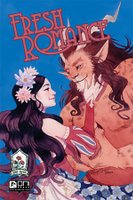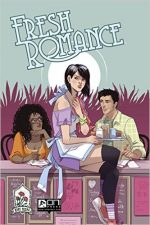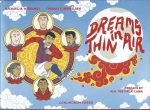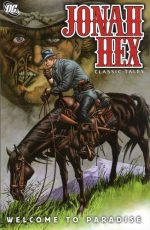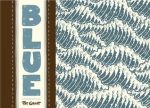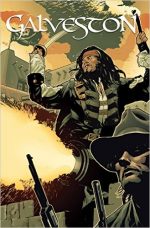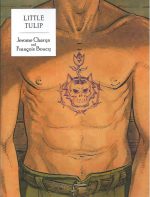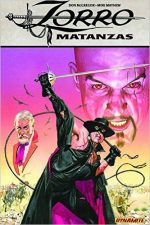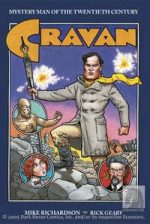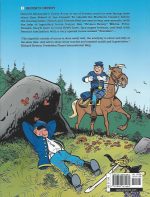
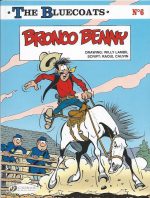
By Willy Lambil & Raoul Cauvin, translated by Erica Jeffrey (Cinebook)
ISBN: 978-1-84918-146-4
The glamour of the American Experience has fascinated Europeans virtually since the actual days of owlhoots and gunfighters. Hergé was an absolute devotee, and the spectrum of memorable comics ranges from Italy’s Tex Willer to such Franco-Belgian classics as Blueberry and Lucky Luke, and even to colonial dramas such as Pioneers of the New World or Milo Manara & Hugo Pratt’s Indian Summer.
Les Tuniques Bleues began at the end of the 1960s, created by Louis “Salvé†Salvérius & Raoul Colvin – who has solo-written every best-selling volume since. The strip was created to replace Lucky Luke when the laconic gunslinger defected from weekly anthology Spirou to rival comic Pilote, and his rapidly-rendered replacement swiftly became one of the most popular bande dessinée series on the Continent.
Salvé was a cartoonist of the Gallic big-foot/big-nose humour style, and when he died suddenly in 1972 his replacement, Willy “Lambil†Lambillotte slowly introduced a more realistic – although still broadly comedic – illustrative manner. Lambil is Belgian-born (in 1936) and – after studying Fine Art in college – joined publishing giant Dupuis as a letterer in 1952.
Born in 1938, scripter Raoul Cauvin is also Belgian and before joining Dupuis’ animation department in 1960 studied Lithography. He soon discovered his true calling as a comedy writer and began a glittering and prolific career at Spirou.
In addition to Bluecoats he has written dozens of other long-running, award winning series including Cédric, Les Femmes en Blanc and Agent 212: more than 240 separate albums. The Bluecoats alone has sold more than 15 million copies.
The sorry protagonists of the series are Sergeant Cornelius Chesterfield and Corporal Blutch: a pair of worthy fools in the manner of Laurel and Hardy, hapless, ill-starred US cavalrymen posted to the wild frontier and various key points of mythic America.
The original format was single-page gags about an Indian-plagued Wild West fort, but with the second volume ‘Du Nord au Sud’ (North and South) the sad-sack soldiers went back East to fight in the American Civil War (this tale was rewritten in the 18th album ‘Blue rétro’ to describe how the chumps were drafted into the military during the war). All subsequent adventures, despite ranging far beyond the traditional environs of America and taking in a lot of genuine and thoroughly researched history, are set within the timeframe of the Secession conflict.
Blutch is your average whinging little-man-in-the street: work-shy, mouthy, devious and especially critical of the army and its inept commanders. Ducking, diving, even deserting whenever he can, he’s you or me – except sometimes he’s quite smart and heroic if no other easier option is available.
Chesterfield is a big burly man; a career soldier who has passionately bought into all the patriotism and esprit-de-corps of the Military. He is brave, never shirks his duty and wants to be a hero. He also loves his cynical little pal. They quarrel like a married couple, fight like brothers but simply cannot agree on the point and purpose of the horrendous war they are trapped in…
Bronco Benny is the sixth translated Cinebook album (chronologically the 16th French volume) and opens with our surly stalwarts waiting at a rail depot for much-needed fresh materiel…
As usual the war has stalled due to lack of crucial resources. This time the dearth is horses to ride, but when the train carrying the replacement mounts unloads, what Chesterfield and Blutch find is a shambles which makes them want to laugh and cry…
The smugly-isolated General Staff quickly retire to their comfortable residence and are soon back in high-level conference. Callously obnoxious Young Turk Captain Stillman posits a most practical – if appallingly unethical – solution to the equine stalemate: don’t pay the soldiers until after the forthcoming battle and use the money to purchase mounts from horse traders beyond the western mountains. To make sure the sale and transport goes according to plan the Captain intends sending the smallest military detail possible, but they will be accompanied by Bronco Benny, the greatest horse-breaker in the world…
Next day, luckless Blutch and Chesterfield set out on the suicide mission they have been volunteered for with strong, silent Benny in attendance. They are astounded by how easily they pass through Confederate pickets and defences. They also have no idea that the enemy is well aware of the plan and is allowing them expedited passage…
Travelling the arid rocky region to the traders’ ranch our heroes are surprised when a band of Indians attack. The Bluecoats only escape through sheer dumb luck and after rendezvousing with the mustang-hunters discover the natives are in uproar because the horsemen have captured a magnificent white stallion the Indians revere as a god…
It’s love at first sight for Benny. He is utterly smitten with the mustang dubbed “Traveller†and the next few days fade to a bruised blur as he strives to break the mighty wonder horse. Sadly, after he does, the true nature of the horse-traders is exposed and Blutch and Chesterfield realise they’ve been suckered yet again…
However, even after being deprived of cash, horses and dignity and left to die at the hands of the furious Indians, Sarge has a plan to fix things and, whilst it doesn’t exactly work as expected, it does get him and his pals back to Union lines in time to witness one more horrific, pointlessly stupid battle and subsequent slaughter with no apparent winner…
This is another hugely amusing savagely anti-war saga targeting young and less cynical audiences. Historically authentic, always in good taste despite its uncompromising portrayal of violence, the attitudes expressed by the down-to-earth pair never make battle anything but arrant folly and, like the hilarious yet insanely tragic war-memoirs of Spike Milligan, these are comedic tales whose very humour makes the occasional moments of shocking verity doubly powerful and hard-hitting.
Fun, informative, beautifully realised and eminently readable, Bluecoats is the sort of war-story that appeals to the best, not worst, of the human spirit.
© Dupuis 1980 by Lambil & Cauvin. English translation © 2012 Cinebook Ltd. All rights reserved.

